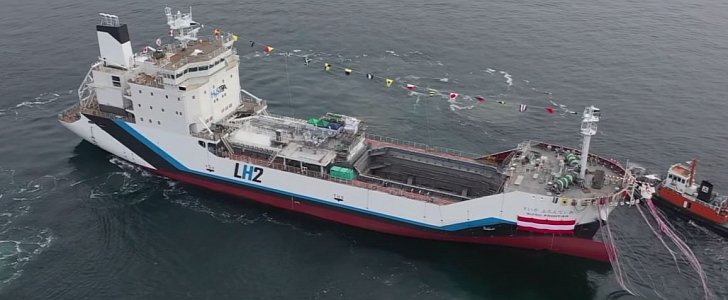In what is perhaps the mother of all ironies, Japan has launched a pilot program aimed at creating a carbon-free society by outsourcing its pollution to Australia. It has also launched the world’s first liquid hydrogen transport ship.
The launch took place last week and marked the beginning of a collaboration between Kawasaki Heavy Industries, Iwatani Corporation, Shell Hapan and J-Power. The goal of the pilot is to start a hydrogen energy international supply chain with the goal of having liquid hydrogen replace natural gas and petroleum.
The Suiso Frontier is the first vessel in the world to transport liquid hydrogen internationally. It will travel from Australia to Kobe, Japan, carrying 1,250 cubic meters (330,215 gal) of liquid hydrogen cooled at -253° C (-423.4° F) in vacuum-insulated containers. Measuring 116-meter (381-ft), Suiso Frontier runs on diesel.
By making regular shipments from Australia to Japan, the vessel will enable a wider use of liquid hydrogen in anything from cars to trucks and probably aircraft. Liquid hydrogen has the advantage of generating no emissions during use, so it would make for a viable option to gas-guzzlers of all types, in the context of the current climate crisis.
That’s the good part of this pilot program.
What Kawasaki isn’t saying is that making all that liquid hydrogen will actually release huge amounts of CO2. As New Atlas points out, Japan is probably not overly concerned about this, since the bulk of pollution will happen in Australia, so it’s like it’s outsourcing its pollution.
The liquid hydrogen will be made in Latrobe Valley, in Victoria, Australia, through gasification of brown coal. The report notes that “some 160 tons” of coal will be used to make 3 tons of hydrogen, which will then be transported by truck for 150 kilometers, loaded onto Suiso Frontier and ferried to Japan.
Making 3 tons of liquid hydrogen through this process will generate 100 tons of CO2, all of which will be released in Australia. “Unless and until this project captures and stores its emissions, the project will produce some of the dirtiest fuel possible,” Melbourne University's Simon Holmes à Court, Senior Energy Adviser to the Energy Transition Hub, points out.
So much for a carbon-free society. In Australia, at least.
The Suiso Frontier is the first vessel in the world to transport liquid hydrogen internationally. It will travel from Australia to Kobe, Japan, carrying 1,250 cubic meters (330,215 gal) of liquid hydrogen cooled at -253° C (-423.4° F) in vacuum-insulated containers. Measuring 116-meter (381-ft), Suiso Frontier runs on diesel.
By making regular shipments from Australia to Japan, the vessel will enable a wider use of liquid hydrogen in anything from cars to trucks and probably aircraft. Liquid hydrogen has the advantage of generating no emissions during use, so it would make for a viable option to gas-guzzlers of all types, in the context of the current climate crisis.
That’s the good part of this pilot program.
What Kawasaki isn’t saying is that making all that liquid hydrogen will actually release huge amounts of CO2. As New Atlas points out, Japan is probably not overly concerned about this, since the bulk of pollution will happen in Australia, so it’s like it’s outsourcing its pollution.
The liquid hydrogen will be made in Latrobe Valley, in Victoria, Australia, through gasification of brown coal. The report notes that “some 160 tons” of coal will be used to make 3 tons of hydrogen, which will then be transported by truck for 150 kilometers, loaded onto Suiso Frontier and ferried to Japan.
Making 3 tons of liquid hydrogen through this process will generate 100 tons of CO2, all of which will be released in Australia. “Unless and until this project captures and stores its emissions, the project will produce some of the dirtiest fuel possible,” Melbourne University's Simon Holmes à Court, Senior Energy Adviser to the Energy Transition Hub, points out.
So much for a carbon-free society. In Australia, at least.





